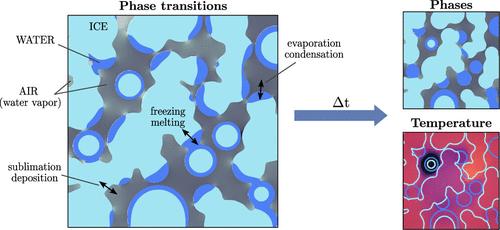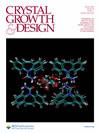A Phase-Field Model for Wet Snow Metamorphism
IF 3.2
2区 化学
Q2 CHEMISTRY, MULTIDISCIPLINARY
引用次数: 0
Abstract
The microstructure of snow determines its fundamental properties such as mechanical strength, reflectivity, or thermo-hydraulic properties. Snow undergoes continuous microstructural changes due to local gradients in temperature, humidity, or curvature, in a process known as snow metamorphism. In this work, we focus on wet snow metamorphism, which occurs when the temperature is close to the melting point and involves phase transitions among liquid water, water vapor, and solid ice. We propose a pore-scale phase-field model that simultaneously captures the three relevant phase change phenomena: sublimation (deposition), evaporation (condensation), and melting (solidification). The phase-field formulation allows one to track the temperature evolution among the three phases and the water vapor concentration in the air. Our three-phase model recovers the corresponding two-phase transition model when one phase is not present in the system. 2D simulations of the model unveil the impact of humidity and temperature on the dynamics of wet snow metamorphism at the pore scale. We also explore the role of liquid melt content in controlling the dynamics of snow metamorphism in contrast to the dry regime before percolation onsets. The model can be readily extended to incorporate two-phase flow and may be the basis for investigating other problems involving water phase transitions in a vapor–solid–liquid system, such as airplane icing or thermal spray coating.

湿雪变质作用的相场模型
雪的微观结构决定了其基本特性,如机械强度、反射率或热液压特性。由于局部的温度、湿度或曲率梯度,雪的微观结构会发生持续变化,这一过程被称为雪的变质作用。在这项研究中,我们重点关注湿雪变质,这种变质发生在温度接近熔点的时候,涉及液态水、水蒸气和固态冰之间的相变。我们提出了一种孔隙尺度相场模型,可同时捕捉三种相关的相变现象:升华(沉积)、蒸发(冷凝)和熔化(凝固)。相场模型可以跟踪三相之间的温度变化以及空气中的水蒸气浓度。当系统中某一相不存在时,我们的三相模型可恢复相应的两相过渡模型。该模型的二维模拟揭示了湿度和温度对孔隙尺度湿雪变质动力学的影响。我们还探索了液态熔体含量在控制雪变质动力学中的作用,与渗流开始前的干燥状态形成对比。该模型可以很容易地扩展到两相流动,并可作为研究气-固-液系统中涉及水相转变的其他问题(如飞机结冰或热喷涂)的基础。
本文章由计算机程序翻译,如有差异,请以英文原文为准。
求助全文
约1分钟内获得全文
求助全文
来源期刊

Crystal Growth & Design
化学-材料科学:综合
CiteScore
6.30
自引率
10.50%
发文量
650
审稿时长
1.9 months
期刊介绍:
The aim of Crystal Growth & Design is to stimulate crossfertilization of knowledge among scientists and engineers working in the fields of crystal growth, crystal engineering, and the industrial application of crystalline materials.
Crystal Growth & Design publishes theoretical and experimental studies of the physical, chemical, and biological phenomena and processes related to the design, growth, and application of crystalline materials. Synergistic approaches originating from different disciplines and technologies and integrating the fields of crystal growth, crystal engineering, intermolecular interactions, and industrial application are encouraged.
 求助内容:
求助内容: 应助结果提醒方式:
应助结果提醒方式:


